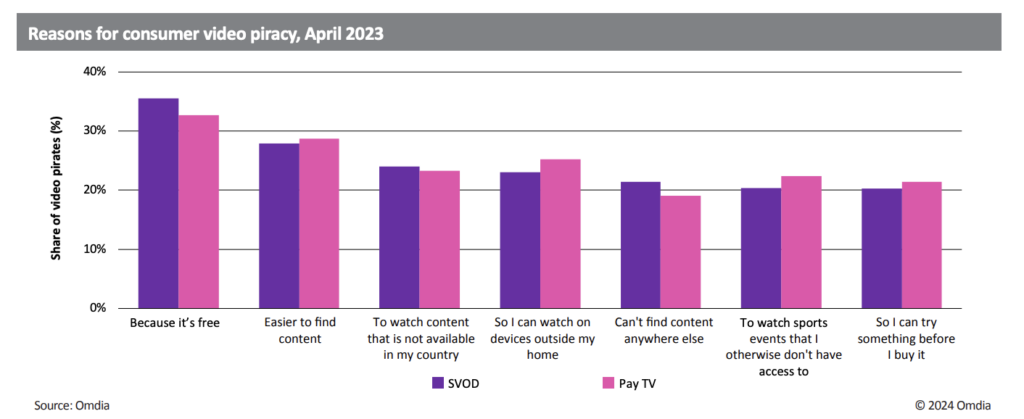DTVE Data Weekly: Understanding modern video piracy

Source: Omdia
Across the territories studied by the Omdia Consumer Research survey in April 2023, 23% of the 28,936 respondents said they used unauthorised websites to access content. There was a greater tendency to pirate (i.e., consume video content through illegal platforms versus the overall population) from both pay-TV and SVOD users, with slight variations between each. The proportion is higher when looking at paid video sectors. For both pay-TV and online video users, 26% of respondents consume content through piracy.
This marks a behaviour in itself: accessibility to content via illegal websites is still a plausible option to more than one in four people taking any paid service. We also asked respondents the main reasons for such behaviour. Apart from being free, other factors such as content discoverability and availability were prevalent.
Regarding their reasons for video piracy, respondents who also take pay TV outranked those using online video in terms of issues around discoverability, accessibility (watching out of home), sports content, and trial features. This shows a clear issue for pay-TV providers to address, first with multiscreen features to improve accessibility, UI to address discoverability, and negotiating relevant sports deals for customers.
Accessibility and content availability
In the case of respondents taking online video, the two main issues are the difficulty of finding content on paid platforms and the local availability of content. Distribution rights are spread across different services, and with proprietary services such as (HBO) Max, Paramount+, and Disney+, it becomes costly for the consumer to access the desired content. On the other hand, desired content may not be available in their territory, leaving them with no choice but to access it via an unauthorised website.
Among video pirates, 90% are part of an SVOD household, and 70% are part of a pay-TV household. Fifty-seven percent take Netflix, 50% subscribe to Prime Video, and 28% take Disney+, which shows SVOD remains relevant among active pirate website users, meaning unauthorised sites are far from replacing streaming services. For more than two-thirds of video pirates, having the latest movies is a top driver; for around half of the respondents, the availability of comedy series and drama series, followed by sports, are the top genre drivers for subscribing to an SVOD service.
Although unauthorised websites remain persistent worldwide, with a significant number of video consumers using them to access content, legitimate paid services remain the main way to access video content. Nevertheless, if addressed, these cases could result in substantially more revenue for content providers and services that can address the increasingly prevalent reasons for piracy beyond content being free.
Juan Villegas, is Omdia’s Media & Entertainment research analyst
